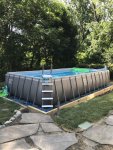First time pool owner. I never bought a pool before because I'm not a fan of chemicals. However, I bought the Intex pool this year after learning about saltwater generators produce a much lower level of chlorine.
I only had the pool for 1 week now and the water looks fine but I have few concerns.
Mainly my free chlorine, PH, and Hardness is low. So I ran the SWG on "boost" mode in hopes of producing my chlorine and correcting that. I also bought stabilizer but been hesitant to add it as I rather resolve this without chemicals
1. My question: If I run the SWG longer and cover the pool every day when not in use, can I avoid adding stabilizer?
Also, My PH and calcium hardness is also showing to be very low. However, I think I can disregard that as I have read online that saltwater naturally raises PH over time and if my above ground pool consists of a vinyl liner, the hardness is not important.
2. Can you confirm that PH and Hardness are not important to correct now.
I"m doing all these tests using the free 4-way Intex test strips. Not sure how reliable these are but I saw the kits others recommend on this board and they look pretty expensive. (or maybe my hesitation is partly in attempt to avoid chemicals all together.
3. Are they any cheap test strips you would recommend over other?

This is my very first post. I'm supper confused about all this and feel a little naive to thinking that I can have a "chemical minimal pool." Any help would be greatly appreciated.
I only had the pool for 1 week now and the water looks fine but I have few concerns.
Mainly my free chlorine, PH, and Hardness is low. So I ran the SWG on "boost" mode in hopes of producing my chlorine and correcting that. I also bought stabilizer but been hesitant to add it as I rather resolve this without chemicals
1. My question: If I run the SWG longer and cover the pool every day when not in use, can I avoid adding stabilizer?
Also, My PH and calcium hardness is also showing to be very low. However, I think I can disregard that as I have read online that saltwater naturally raises PH over time and if my above ground pool consists of a vinyl liner, the hardness is not important.
2. Can you confirm that PH and Hardness are not important to correct now.
I"m doing all these tests using the free 4-way Intex test strips. Not sure how reliable these are but I saw the kits others recommend on this board and they look pretty expensive. (or maybe my hesitation is partly in attempt to avoid chemicals all together.
3. Are they any cheap test strips you would recommend over other?

This is my very first post. I'm supper confused about all this and feel a little naive to thinking that I can have a "chemical minimal pool." Any help would be greatly appreciated.


 There, now the bluntness and terrible humor is out of the way, we can get down to business
There, now the bluntness and terrible humor is out of the way, we can get down to business